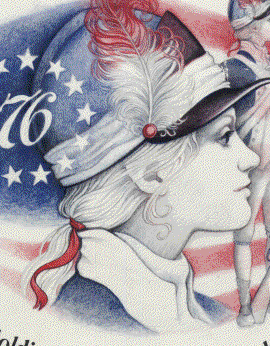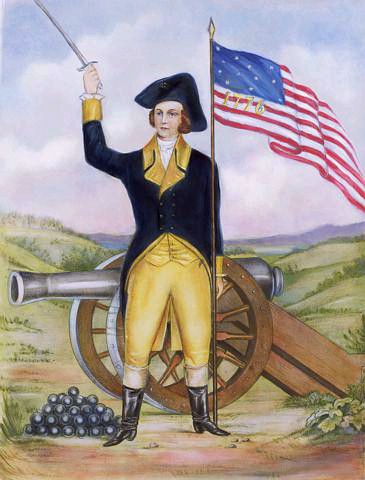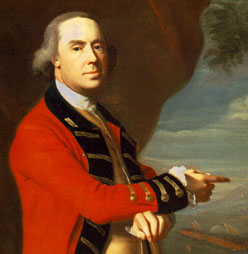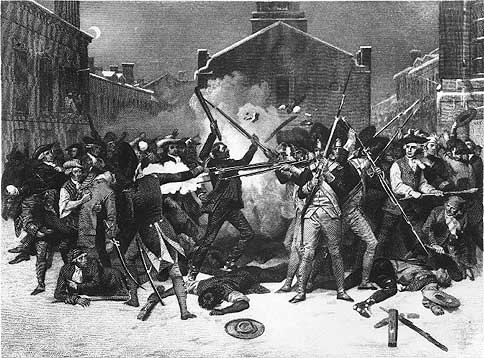A long and brutal battle between two European superpowers, France and England, for control of the upper Ohio River valley. Fort Duquesne, guardian of the gateway to the west, was renamed Fort Pitt and within two years would become England's mightiest fortification in America. Although the bloody struggle for domination in the New World would not come to an end until the British victory on Quebec's Plains of Abraham and the total defeat of New France, the wheels had been set in motion for the colonies' fight for independence.
The French and Indian War was precipitated through a series of altercations over rights to land in the Upper Ohio Valley. In April 1754, a force of French and Indians traveling down the Allegheny River, with orders from the governor-general of New France to claim this prized territory for France, encountered a small garrison at the forks of the Ohio. This was a strategic location for both the French, who sought unfettered access between their North American settlements on the Great Lakes and Mississippi River, and the British who craved fresh territory for their colonies' expansion. Both coveted the lucrative fur trade with the Indians beyond the Allegheny Mountains. The garrison in question was Fort Prince George, established some months earlier by the young Colonel George Washington while scouting for Virginia's Ohio Land Company. Declaring the area "extremely well-situated for a fort, having command of both rivers," Washington established a British settlement that would eventually develop into the city of Pittsburgh.
Fort Prince George was an unimposing trading post surrounded by a stockade, but it undoubtedly served as an obstacle to the French. Overpowered, the occupants surrendered and were permitted to vacate the fort with their tools and arms intact. The French then set about building their own massive fortification that they named Fort DuQuesne in honor of their governor-general. From this vantage point, they held sway over the Ohio Valley. However, their supremacy would be short-lived.
Tensions escalated as the British returned time and again trying to reclaim the site. Under George Washington's command, a small force engaged and defeated a scouting party of French and Indians near Fort Duquesne. Unable to proceed against the superior French forces in the fort, Washington erected Fort Necessity at nearby Great Meadows. Within a few months, the French countered and the assault forced Washington to surrender Fort Necessity and return to Virginia. This was the first major battle in the French and Indian War. Washington would return the following year, in July 1755, as a volunteer aide-de-camp for General Braddock to again attempt to rouse the French from Fort Duquesne. The battle proved a disaster for the British troops who were unaccustomed to the terrain, the weather, and the guerilla tactics of the Indians. General Braddock was killed in the melee but gave his name to the road his soldiers carved out of the western Pennsylvania wilderness.
On May 15, 1756, with official declaration of hostilities that extended far beyond Pennsylvania, the Seven Years' War began between France and England. Involving all the major European powers, it was the first global conflagration that engulfed all the territories colonized by the French and English from North America to Europe, the West Indies, Africa and India. But the principle struggle remained in North America, where events would not bode well for the English until the elder William Pitt came to power as British Prime Minister in 1756. By the end of 1757, with increased British resources, greater demands on the colonists, and the French facing national bankruptcy, the tide began to turn.
In the summer of 1758, General John Forbes commanded an expedition of nearly 7,000 men over the Alleghenies, carving out a highway that would later be known as Forbes Road. An advance column under Major James Grant made an unsuccessful attempt to take over Fort Duquesne. Aware that Grant's troops were closing in, the French and Indians rushed out from the fort to prevent their advance from the area that is now known as Grant Street in Pittsburgh. Discovering that the French were now in a much weaker position, General Forbes' immense force descended on the fort in mid-November. They met no resistance, as the French had already burned and abandoned Fort Duquesne, and fled on the rivers.
The years 1758-1759 also brought British victories in New France that culminated with the defeat of Quebec. On February 10, 1763, the Treaty of Paris was signed by Great Britain, France and Spain, ending hostilities abroad and signaling British domination in North America. By terms of the treaty, France ceded Canada and all its territory east of the Mississippi River to England, and Spain yielded Florida to England. The treaty signified the colonial and maritime supremacy of Great Britain. But that success would prove costly. The British Parliament's attempt to cover its overwhelming war debts and to pay for a continuing military presence in America by direct taxation of the colonists soon caused strained relations with the colonies and presaged the War of Independence.
 Benjamin Franklin was born in Boston January 17, 1706 to Josiah Franklin and Abiah Folger. Benjamin was the 10th of the seventeenth chilchren from Josiah Franklin. Benjamin's parents couldnt afford to send him to school so he only went one year. His father knew that Benjamin liked to read so he send him at the age of 12 to his older brother, James, who was a printer in there Benjamin composed pamphlets between other things. When he was 15, James started a newspaper but James didnt let Benjamin express in the Newspaper his point of view so Benjamin wrote to him by the name of a widow "Silence Dogood". This articles ecame very famous, after time Benjamin told his brother that didnt took it well. Later James wassent to jail because of his views, so Benjamin took care of the newspaper but his brother instead of thanking him he beat him up and this caused Benjamin to run away when he was 17.
Benjamin Franklin was born in Boston January 17, 1706 to Josiah Franklin and Abiah Folger. Benjamin was the 10th of the seventeenth chilchren from Josiah Franklin. Benjamin's parents couldnt afford to send him to school so he only went one year. His father knew that Benjamin liked to read so he send him at the age of 12 to his older brother, James, who was a printer in there Benjamin composed pamphlets between other things. When he was 15, James started a newspaper but James didnt let Benjamin express in the Newspaper his point of view so Benjamin wrote to him by the name of a widow "Silence Dogood". This articles ecame very famous, after time Benjamin told his brother that didnt took it well. Later James wassent to jail because of his views, so Benjamin took care of the newspaper but his brother instead of thanking him he beat him up and this caused Benjamin to run away when he was 17.

































